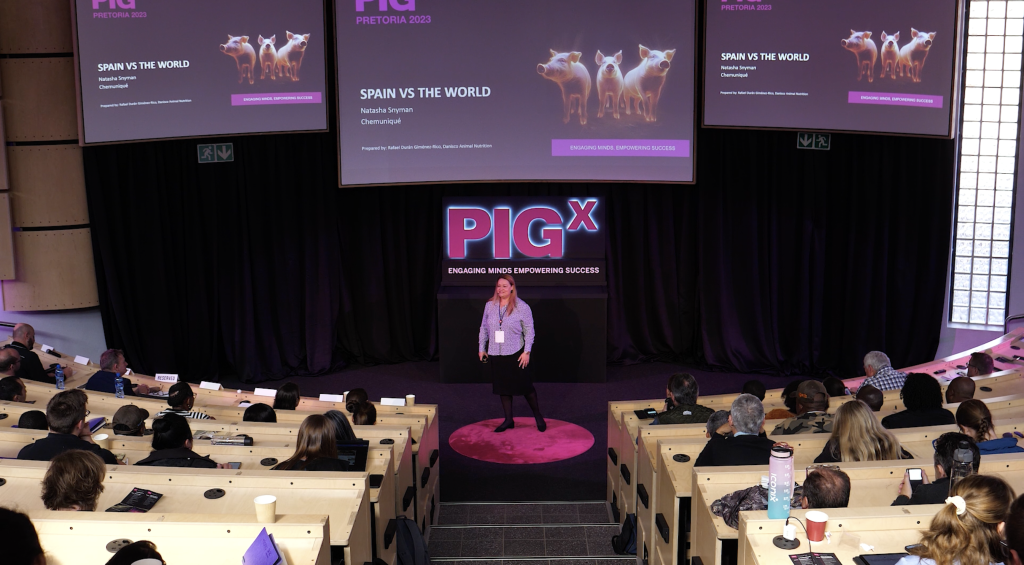Spain’s strict disease management, which resulted in the eradication of African swine fever (ASF) in 1993, combined with its sustainable practices and strong focus on innovation, has positioned the country as a global leader in pork production as it continues to adapt to fluctuating market dynamics and evolve within a rapidly changing global landscape. Natasha Snyman, chief operations officer at Chemuniqué, shared the lessons that the South African pig industry can learn from its Spanish counterpart.
Spain is passionate about the fruits of its labour, as food is such a deeply ingrained ritual within its culture. Spaniards have immense respect for the origin and quality of their produce. Over the centuries, this has seen the swine industry become a fundamental component of the country’s agricultural landscape with an average pork consumption of 49 kg per person annually, said Snyman.
Spain’s scientific advancements
She said the local industry underwent significant modernisations as of 2012 that saw an increase in farm sizes (that have only plateaued recently after growing exponentially in the last decade) and improvements to their production techniques. “The integration of advanced technologies, improved farm management procedures, and the implementation of ground-breaking scientific knowledge resulted in a higher long-term productivity of sows (down by 12% year-on-year in 2022), improved animal welfare, and enhanced biosecurity measures.”

Compared with its European counterparts, Spain, on average, has larger farms and the largest number of free-farrowing farms on the continent. “Close to two-thirds (60%) of Spain’s approximately 86 000 pig farms have adopted an integration model that enables farmers to produce pork with much lower risk, where companies supply the animals, feed, and veterinary services to farmers who contract-rear the animals,” Snyman said. This has seen the country increase the number of pigs it produces on an ongoing basis as of 2016, with a slight downward trend of pigs weaned/sow/year of roughly 1,8 fewer piglets per slaughtered sow in 2022. This has seen slaughtering capacity exceed Spain’s production capacity and the country imported between 4 and 5 million weaners last year, which impacts biosecurity. “Spain, however, remains the number one pork producer in the European Union, and the third globally, while other European countries are seeing a huge drop in production.”
Europe’s dwindling pork production
Snyman explained that Europe’s decreased pork production is as a result of high raw material prices, driven by poor crop production in some parts of the world and the ongoing Russia–Ukraine war. “China has substantially reduced its pork imports from the European Union. The spread of ASF from Eastern Asia to Western Europe is another factor. Consequently, Europe’s contribution to the global pork trade in terms of carcass weight equivalent has decreased.”
Fortunately, Spain eradicated ASF as of 1993 and has been shielded from infection due to its geographic location and excellent biosecurity measures for imported animals, all while the country is working on an ASF vaccine.
Hyperprolific sows
“Spain has managed its hyperprolific sows – which give birth to more piglets than their 14–16 functional teats – with a focus on pre-farrow feeding,” said Snyman.

By 2012, Spain’s number of piglets per litter were 13,23; today, the average number is 16,25. The larger the number of piglets in a litter, the lower the average birth weight and the higher the variation in terms of birth weight across the litter, all of which affects the piglets’ access to colostrum and milk. The minimum colostrum intake for good liveability is around 250 g per piglet per day, which is easily achievable if the piglet’s birth weight is above 1 kg. If, however, the birth weight is below 1 kg, the piglets may struggle to reach a 250 g colostrum intake, and with this, mortalities increase to around 40% and even up to 60%.
Positive effects of ad libitum pre-farrow feeding
Traditionally, limiting feed intake during the pre-farrowing period is recommended to prevent long parturition times and impaired lactational feed intake. Recent studies have evaluated the possible positive effects of increasing feed allowances to ad libitum feeding around four to five days before farrowing. This has had positive results on piglet weaning weight and has seen a reduction of back fat and body weight loss in sows. Providing ad libitum feed pre-farrowing promotes feed intake during and after farrowing. This, in turn, mobilises body reserves to maintain body condition throughout lactation. The findings suggest that farrowing duration, farrowing assistance, and stillbirth rates were reduced the closer the last meal was consumed before parturition.
The European Union’s high-dose zinc oxide ban
As of 2022, the European Union banned the use of high doses of zinc oxide in veterinary drugs, limiting it to 150 ppm. Despite the fact that it has been used extensively in the pork-producing industry to manage post-weaning diarrhoea, there have been concerns over environmental contamination due to the amount of zinc excreted by piglets. As pig manure is used for fertiliser, large amounts of zinc spread to soil, which affected the absorption of other trace elements, such as iron, and also negatively influenced the synthesis of chlorophyll by plants. Furthermore, zinc may accumulate in animals’ livers and surface water, which also raises concerns.
“Unfortunately, there is no single replacement, instead we require more of a holistic approach. Improved biosecurity measures, sound vaccination protocols, and a reduction in environmental and weaning stress may all play a part in the solution. Feed formulation adjustments and the strategic use of feed additives could also contribute to the prevention of post-weaning diarrhoea.” Snyman concluded, saying that the Spanish swine industry is testament to the nation’s dedication to agricultural excellence. “From its historical origins to its present-day prominence in the global market, it continues to evolve and embrace modernisation, sustainability and animal welfare.
With a rich tradition of producing high-quality pork products and a commitment to innovation, Spain’s swine industry is poised to remain a cornerstone of the country’s agricultural success well into the future. It is with great humility that the global industry owes Spain immense gratitude for everything we have learned through their example.”
The South African Pork Producers’ Organisation (SAPPO) coordinates industry interventions and collaboratively manages risks in the value chain to enable the sustainability and profitability of pork producers in South Africa.
















